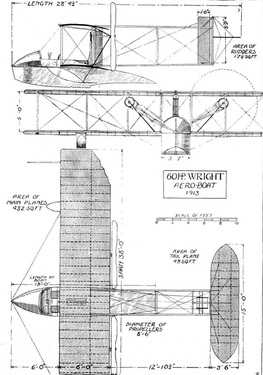
Happy New Year to all of our fellow aviation enthusiasts following Wright Seaplane Base, Inc.!
Last week we traveled to Indianapolis and presented on the Wright Brothers’ early contributions to floatplane and flying boat technology. It never seizes to amaze me how these “Gentlemen Aviators,” influenced our modern American history and helped pave the way to our modern and ever-changing aviation industry.
We all know of the famous December 17, 1903 flight where the Wright Brothers proved that humanity could indeed join the ranks with birds with their flying machine… But do you know of all the other contributions Orville and Wilbur gave to aviation? In all the Wrights, early influence on aviation history stirred many great innovations that contributed to our aviation and seaplane technology. Some early seaplane technologies such as retractable wheels, unique stepped floats, angle-of-attack gauges, automatic stabilizers and auxiliary engine starters proved to be remarkable advancements still employed today to enhance our aviation experience.
Just as Orville and Wilbur dared to pursue their “impossible” dream, we too must push to inspire other young visionaries to do the same. After Wilbur’s passing to typhoid fever, Orville gave a young engineering student and graduate of Columbia University, Grover Loening, a chance to share his passion for Aeronautics. Under the direction of Orville, this newly minted Chief Engineer of the Wright Company, was given an opportunity to help Orville develop an effective design for a flying boat, the Wright Model G Aeroboat. The Model G Aeroboat was a deep-water flying boat design that could carry two people in tandem and meant for use by the U.S. Navy. The design was successfully tested many times off of the Great Miami River, South of Dayton, Ohio. It proved itself marketable as entrepreneurs attempted to open a floatplane school at the Glenwood Country Club in Glen Head, NY using the Wright Model G Aeroboat.
Not unlike the Wright Brothers, many of our young minds today also possess an “impossible” dream. Just as Orville and Wilbur used their talent and passion for science, technology, engineering, and math to conquer flight; it is our duty to inspire such aspirations. We must enable the upcoming generation to explore and challenge the sciences to foster in the next wave of innovation! This is why Wright Seaplane Base, Inc. has added to their charter a commitment to facilitating opportunities for young innovators residing in our local community for 2015 and beyond!
Continue to follow this blog for upcoming developments and other notes regarding the Wright Brothers and other significant events in aviation history! Feel free to contact us via our contact page or to this blog, if you have any questions and/or comments. If you would like to contribute to any of our 2015 goals click here or on the donate button. Thank you and Happy New Year from WSBI!
J. L. Manresa
Last week we traveled to Indianapolis and presented on the Wright Brothers’ early contributions to floatplane and flying boat technology. It never seizes to amaze me how these “Gentlemen Aviators,” influenced our modern American history and helped pave the way to our modern and ever-changing aviation industry.
We all know of the famous December 17, 1903 flight where the Wright Brothers proved that humanity could indeed join the ranks with birds with their flying machine… But do you know of all the other contributions Orville and Wilbur gave to aviation? In all the Wrights, early influence on aviation history stirred many great innovations that contributed to our aviation and seaplane technology. Some early seaplane technologies such as retractable wheels, unique stepped floats, angle-of-attack gauges, automatic stabilizers and auxiliary engine starters proved to be remarkable advancements still employed today to enhance our aviation experience.
Just as Orville and Wilbur dared to pursue their “impossible” dream, we too must push to inspire other young visionaries to do the same. After Wilbur’s passing to typhoid fever, Orville gave a young engineering student and graduate of Columbia University, Grover Loening, a chance to share his passion for Aeronautics. Under the direction of Orville, this newly minted Chief Engineer of the Wright Company, was given an opportunity to help Orville develop an effective design for a flying boat, the Wright Model G Aeroboat. The Model G Aeroboat was a deep-water flying boat design that could carry two people in tandem and meant for use by the U.S. Navy. The design was successfully tested many times off of the Great Miami River, South of Dayton, Ohio. It proved itself marketable as entrepreneurs attempted to open a floatplane school at the Glenwood Country Club in Glen Head, NY using the Wright Model G Aeroboat.
Not unlike the Wright Brothers, many of our young minds today also possess an “impossible” dream. Just as Orville and Wilbur used their talent and passion for science, technology, engineering, and math to conquer flight; it is our duty to inspire such aspirations. We must enable the upcoming generation to explore and challenge the sciences to foster in the next wave of innovation! This is why Wright Seaplane Base, Inc. has added to their charter a commitment to facilitating opportunities for young innovators residing in our local community for 2015 and beyond!
Continue to follow this blog for upcoming developments and other notes regarding the Wright Brothers and other significant events in aviation history! Feel free to contact us via our contact page or to this blog, if you have any questions and/or comments. If you would like to contribute to any of our 2015 goals click here or on the donate button. Thank you and Happy New Year from WSBI!
J. L. Manresa
 RSS Feed
RSS Feed

